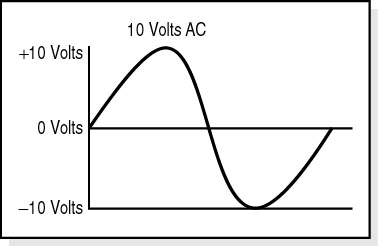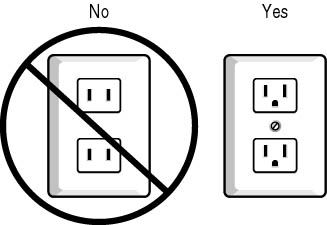AC power is man-made, using generators. As the wire coil inside the generator rotates, it passes by each pole of unit magnet(s) producing an electric current. When it passes the opposite pole, the current reverses, or alternates, the direction of flow (see Figure 13.1). The number of revolutions made by the generator per minute is called its frequency. In the United States, power companies run their systems at 60 turns per second to produce a high-voltage, 60Hz (cycles per second) alternating current as they rotate. The power system drops the voltage in stages before it is connected to the consumer's home or business.

Figure 13.1 Flow of electrons
The power company delivers AC power to our homes or businesses with three wires. Two of the wires are hot, meaning that they carry a charge. One, the bare wire that runs from the breaker box to the power pole, is neutral. The measured voltage between the two hot wires is between 220 and 240 volts AC (VAC), while the measured voltage between either of the hot wires and the neutral wire is between 110 and 120 VAC. These voltages, which are called nominal voltages, can vary by plus or minus (�) 10 percent (see Figure 13.2).

Figure 13.2 AC volts
Typical electrical outlets are connected between one of the hot wires and the neutral wire. These outlets are usually three-prong connections. The smaller rectangular hole is the hot, the larger rectangular hole is the neutral, and the small round hole is called the ground. The ground wire is used as a safety wire. In the event of a short circuit, a large flow of current (amps) is discharged all at one time. This short, high flow of current will burn out circuits unless it can be safely sent somewhere else. Electricity will always seek the path of least resistance to ground. By providing this wire, a short circuit will cause less damage by providing a path for safe dissipation of the current. To provide a safe working environment for the computer and yourself, make sure that this wire is properly installed.
Older structures might have two-wire electrical outlets without the ground wire. An electrical outlet without grounded plugs and the third ground wire is unacceptable for use with a computer (see Figure 13.3). An extension cord without a ground wire is also unacceptable.

Figure 13.3 The proper type of outlet includes a ground
CAUTION
A short circuit can cause physical damage to equipment and personnel. It can cause a fire, component damage, permanent disability, or even death. The ground plug provides a direct connection to ground, giving the electricity an alternate path away from equipment and people.